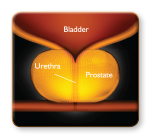Below, we take a deeper dive into the UroLift System for benign prostatic hyperplasia (BPH).
As with all content on Greater Boston Urology's blog, the following information is educational in nature, not medical advice. Always talk to your physician about your specific health care questions and conditions.
[Editor's note: This article was reviewed and updated on 11/17/21.]
What is UroLift for BPH?
The UroLift System treatment is a revolutionary, minimally invasive approach to treating an enlarged prostate, or BPH, that lifts or holds the enlarged prostate tissue out of the way so it no longer blocks the urethra. There is no cutting, heating or removal of prostate tissue.
Clinical data has shown that the UroLift System treatment is safe and effective in relieving lower urinary tract symptoms due to BPH without compromising sexual function1,4. The goal of the UroLift System treatment is to relieve symptoms so you can get back to your life and resume your daily activities.
Most common side effects are light blood in the urine, some pain or discomfort when urinating, some increased urge to go and discomfort in the pelvis that typically resolve within two to four weeks after the procedure.
Advantages of the UroLift System:
- Rapid symptom relief, better than reported for medications2
- Risk profile better than reported for surgical procedures such as TURP3
- Preservation of sexual function1
- Return to normal activity in days not months
- Increased quality of life
- No ongoing BPH medications
- 19 clinical study publications; 4 years published clinical data4
How the UroLift System Works
The UroLift System treatment is a straightforward procedure that is performed by a urologist. The urologist places tiny implants to hold the prostate lobes apart, like open curtains on a window, to relieve compression on the urethra. This allows urine to flow normally again. The UroLift System treatment can be done in the physician’s office under local anesthesia. Typically, patients return home the same day without a catheter.2
Enlarged Prostate: An enlarged prostate compresses on the urethra, making it difficult for urine to flow.

Step 1: The UroLift Device is placed through the obstructed urethra to access the enlarged prostate.

Step 2: Small UroLift Implants are permanently placed to lift and hold the enlarged prostate tissues out of the way and increase the opening of the urethra. The permanent implants are delivered through a small needle that comes out of the UroLift delivery device and into the prostate.

Step 3: The UroLift delivery device s removed, leaving an open urethra designed to provide symptom relief.

In the video below, Dr. Jonathan Brajtbord discusses UroLift:
Are you interested in learning if UroLift is right for you?
Make an appointment with a physician from Greater Boston Urology to discuss your options.
